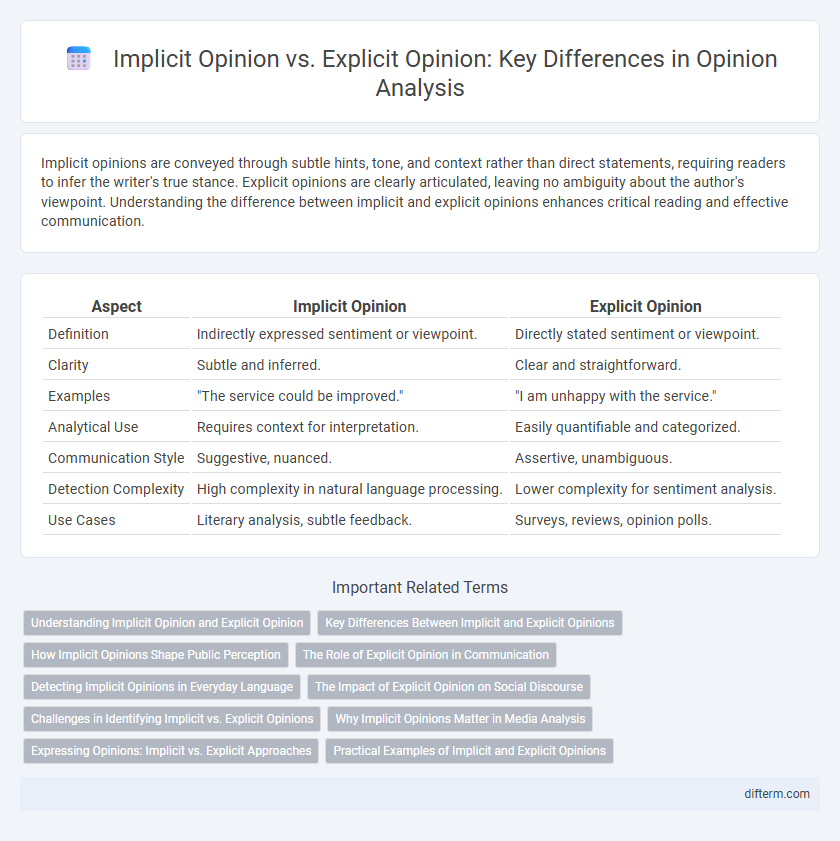Implicit opinions are conveyed through subtle hints, tone, and context rather than direct statements, requiring readers to infer the writer's true stance. Explicit opinions are clearly articulated, leaving no ambiguity about the author's viewpoint. Understanding the difference between implicit and explicit opinions enhances critical reading and effective communication.
Table of Comparison
| Aspect | Implicit Opinion | Explicit Opinion |
|---|---|---|
| Definition | Indirectly expressed sentiment or viewpoint. | Directly stated sentiment or viewpoint. |
| Clarity | Subtle and inferred. | Clear and straightforward. |
| Examples | "The service could be improved." | "I am unhappy with the service." |
| Analytical Use | Requires context for interpretation. | Easily quantifiable and categorized. |
| Communication Style | Suggestive, nuanced. | Assertive, unambiguous. |
| Detection Complexity | High complexity in natural language processing. | Lower complexity for sentiment analysis. |
| Use Cases | Literary analysis, subtle feedback. | Surveys, reviews, opinion polls. |
Understanding Implicit Opinion and Explicit Opinion
Implicit opinions are subtle attitudes or beliefs conveyed indirectly through tone, context, or word choice, requiring careful interpretation to discern underlying meanings. Explicit opinions are clearly stated viewpoints expressed directly through definitive language, leaving little room for ambiguity or misinterpretation. Understanding the distinction between implicit and explicit opinions is crucial for effective communication, enabling accurate perception of both overt statements and nuanced messages.
Key Differences Between Implicit and Explicit Opinions
Implicit opinions are expressed indirectly through tone, context, or suggestion, requiring inference to understand the speaker's true stance, whereas explicit opinions are clearly and directly stated, leaving no ambiguity about the viewpoint. Key differences include the level of clarity, with explicit opinions providing straightforward expression, while implicit opinions rely on subtle cues that may be interpreted differently by each listener. Recognizing these distinctions is crucial for accurately analyzing communication, especially in media, marketing, and interpersonal interactions.
How Implicit Opinions Shape Public Perception
Implicit opinions influence public perception by embedding subtle biases and assumptions that often go unnoticed, guiding attitudes and behaviors unconsciously. These unspoken views are conveyed through language, media, and social cues, shaping collective understanding without direct statements. Recognizing implicit opinions is crucial for critically analyzing public discourse and fostering more transparent communication.
The Role of Explicit Opinion in Communication
Explicit opinion plays a crucial role in communication by providing clear, direct expressions of thoughts and feelings, which reduces ambiguity and enhances understanding. It allows speakers and writers to assert their positions confidently, facilitating more effective persuasion and decision-making. The clarity of explicit opinions strengthens interpersonal relationships by promoting honest and transparent dialogue.
Detecting Implicit Opinions in Everyday Language
Detecting implicit opinions in everyday language requires analyzing context clues, tone, and underlying sentiment that are not directly stated. Techniques such as sentiment analysis, natural language processing, and contextual embedding help identify subtle expressions of opinion embedded in figurative speech or nuanced phrasing. Understanding implicit opinions enhances communication by revealing deeper attitudes and beliefs beyond explicit statements.
The Impact of Explicit Opinion on Social Discourse
Explicit opinion shapes social discourse by providing clear, direct viewpoints that foster transparent communication and facilitate debate. This clarity reduces ambiguity, enabling individuals to engage critically with ideas and hold others accountable for their stances. In contrast to implicit opinions, explicit expressions accelerate consensus-building and influence public policy through unambiguous articulation of values and beliefs.
Challenges in Identifying Implicit vs. Explicit Opinions
Identifying implicit opinions poses significant challenges due to their subtle nature, often relying on context, tone, and inferred meaning rather than direct statements. Explicit opinions are easier to detect as they contain clear, overt expressions of sentiment, typically marked by adjectives or adverbs conveying positive or negative evaluations. Natural language processing models frequently struggle with detecting implicit opinions, as they require advanced semantic understanding and the ability to interpret sarcasm, metaphor, and nuanced language.
Why Implicit Opinions Matter in Media Analysis
Implicit opinions in media analysis reveal underlying biases and cultural nuances often missed by explicit statements, providing deeper insight into content interpretation. They influence audience perception subtly through tone, imagery, and framing, shaping public opinion without overt declarations. Understanding these hidden perspectives is crucial for critically evaluating media messages and uncovering the true intent behind information dissemination.
Expressing Opinions: Implicit vs. Explicit Approaches
Expressing opinions can be divided into implicit and explicit approaches, where implicit opinions convey attitudes subtly through tone, context, or choice of words, allowing readers to infer meaning without direct statements. Explicit opinions, in contrast, clearly articulate beliefs or judgments using decisive language and unambiguous statements, leaving little room for interpretation. Understanding the balance between implicit and explicit expression improves communication effectiveness by tailoring message clarity and emotional impact to the audience's needs.
Practical Examples of Implicit and Explicit Opinions
Implicit opinions often surface through subtle cues such as tone, body language, or choice of words, for example, a sarcastic remark hinting at disapproval without stating it outright. Explicit opinions are clearly stated, such as directly expressing support for a policy or declaring a preference for a particular product. Practical examples include a film review where the reviewer says, "The movie was visually stunning," (explicit) versus saying, "The storyline made me check my watch frequently," which implies dissatisfaction implicitly.
Implicit opinion vs Explicit opinion Infographic

 difterm.com
difterm.com